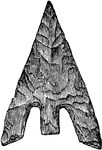
New Fernandina
"Federal troops marching through Second Street, New Fernandina, Fla. Our sketch of New Fernandina in…
New Jersey Troops
"The New Jersey troops crossing the Chesapeake Bay, in sixteen propellers, on their way to Washington,…

Florence Nightingale
"Miss Florence Nightingale did remarkable work during the Crimean War for the relief of sick and wounded…
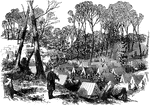
Camp of Ninth Massachusetts
"Camp of the Ninth Massachusetts Regiment in the woods, one mile from the Confederate fortifications,…
Occupation of Norfolk
"Occupation of Norfolk, VA., by the Federal troops- view of the city- Federal vessels at anchor." —Leslie,…

Officer's Tents
"New Jersey Camp at Arling, Va., designated as Camp Princeton in honor of one of the Revolutionary battle…
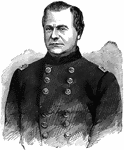
General Richard J. Oglesby
"General Oglesby, born in Oldham County, Ky., July 25th, 1824. Served in the Mexican War; was present…

Old Church
"Desperate skirmish at Old Church, near Tunstall's Station, VA., between a squadron of the Fifth United…
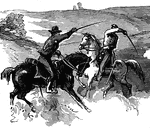
Old Church
"Desperate skirmish at Old Church, near Tunstall's Station, VA., between a squadron of the Fifth United…

Old Church
"Desperate skirmish at Old Church, near Tunstall's Station, VA., between a squadron of the Fifth United…

Landing at Parkersburg
"Landing of Federal troops at Parkersburg, Western Virginia. Parkersburg, Va., in 1861 was a thriving…

Battle of Pea Ridge
"Battle of Pea Ridge, Ark., fought March 6th, 7th and 8th, 1862, between the Federal forces, 13,000…
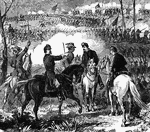
Battle of Pea Ridge
"Battle of Pea Ridge, Ark., fought March 6th, 7th and 8th, 1862, between the Federal forces, 13,000…

Battle of Pea Ridge
"Battle of Pea Ridge, Ark., fought March 6th, 7th and 8th, 1862, between the Federal forces, 13,000…
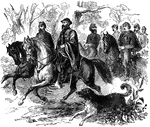
Battle of Pea Ridge
"General Asboth and staff at the Battle of Pea Ridge, Ark., March 6th-8th, 1862. The gallantry displayed…
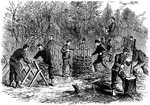
77th Pennsylvania Regiment
"Captain Muller's Battery Company of the Seventy-seventh Pennsylvania Regiment making fascines and gabions…

Picture Writing
An example of Native American picture writing. One interpretation: "The chiefs Black Wolf, Raven, Fast…
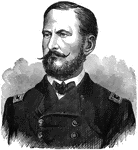
General Alfred Pleasonton
"General Pleasonton, born in Washington, D. C., June 7th, 1824, was graduated at the United States Military…

Police Headquarters
"Interior of the outbuilding attached to Marshal Kane's Police Headquarters, Holliday Street, Baltimore-…

Pontoon bridge
"General Fremont's Division crossing the Pontoon Bridge over the Shenandoah River in pursuit of the…
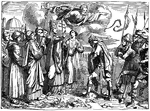
Pope Leo the Great Approaches Attila, King of the Huns, on the Battlefield
Illustration of Pope Leo, dressed in full papal costume and holding the primatial cross, approaches…

Port Royal Ferry
"Successful attack of a detachment of the Federal forces, under General Stevens, supported by four gunboats…
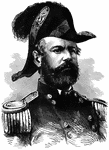
General Fitzjohn Porter
"General Porter, born at Portsmouth, N. H., June 13th, 1822, was graduated from the United States Military…

Battle at Potomac
"Engagement between the Federal troops and the Confederates on the Virginia side of the Potomac, opposite…
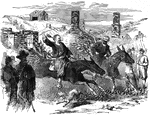
Passage of the Potomac
"A street in Harper's Ferry, VA., during the passage of the Potomac by the Federal troops from Maryland,…

Camp Princeton
"New Jersey Camp at Arling, Va., designated as Camp Princeton in honor of one of the Revolutionary battle…

Prison
"The humors of a prison- scene in a station-house cell, Washington, D. C., after the appointment of…
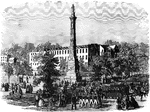
Pulaski Monument
"Review of Confederate troops on their march to Virginia, in front of the Pulaski Monument, Monument…
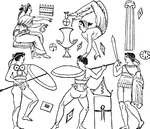
Pyrrhic Dance
"The most famous of all the war-dances of antiquity, is said to have received its name from one Pyrrichos,…
Rappahannock
"The city of Fredericksburg, VA., from the North side of the Rappahannock- from a sketch by our special…

Rappahannock Bridge
"Rebuilding of the railroad bridge over the Rappahannock to Fredericksburg, burnt by the Confederates…
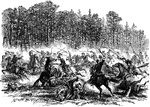
Sixth Regiment
"Gallant charge of the Sixth Regiment, United States Regular Cavalry, upon the Confederate Stuart's…
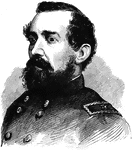
General Jesse L. Reno
"General Reno, born in Wheeling, W. Va., June 20th, 1823, died on South Mountain, Md., September 14th,…
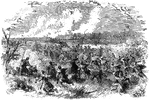
Battle of Roanoke Island
"Battle of Roanoke Island, February 8th, 1862- decisive bayonet charge of the Ninth New York Volunteers…
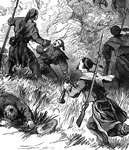
Battle of Roanoke Island
"Battle of Roanoke Island, February 8th, 1862- decisive bayonet charge of the Ninth New York Volunteers…

Battle of Roanoke Island
"Battle of Roanoke Island, February 8th, 1862- decisive bayonet charge of the Ninth New York Volunteers…
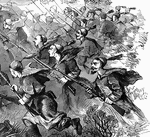
Battle of Roanoke Island
"Battle of Roanoke Island, February 8th, 1862- decisive bayonet charge of the Ninth New York Volunteers…

Rolla Camp
"Encampment of the Federal army near Rolla, Mo. The city of Rolla has been famous since the death of…

Engagement at Romney
"Engagement at Romney, VA., twenty miles from New Creek, Tuesday, June 11th, 1861- the Eleventh Indiana…

General Rosecrans
"General Rosecrans, commanding the Department of Western Virginia, surrounded by his staff, at their…
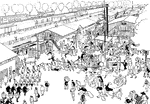
Ruhleben Prison Camp
"A prophetic birds eye view of Ruhleben Prison Camp when the war ends."-1916; Drawing by Hobart Egremont,…
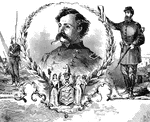
Theodore Runyon
"New Jersey Camp at Arling, Va., designated as Camp Princeton in honor of one of the Revolutionary battle…

Battle of Savages Station
"Battle of Savages Station. Brigadier General Smith's division hotly engaged with the enemy, at noon,…
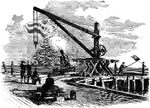
Sawyer gun
"Practicing with the celebrated Sawyer gun on the Confederate batteries at Swell's Point, near Norfolk,…

Schooners
"Removing sunken schooners from Core Sound, N. C., placed to obstruct the passage of the Federal gunboats,…

Battle of Secessionville
"Battle of Secessionville, James Island, S. C.- bayonet charge of Federal troops, commanded by General…

Second Naval Battle
"Second naval battle in Hampton Roads- fight between the Federal ironclad Monitor, of two guns,…
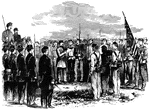
Seventy-ninth Regiment
"Taking away the colors of the Seventy-ninth New York Regiment for insubordination and mutiny, Washington,…

Crossing of Shenandoah River
"Colonel Pilson's Battery shelling the rear guard of the Confederate General Jackson's Army, at the…

Shenandoah Valley
"The army of General Fremont on its march up the Shenandoah Valley- wounded and ragged soldiers. Fremont…




